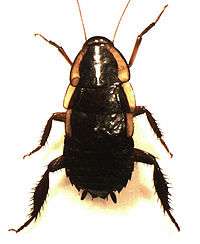Drymaplaneta semivitta
Drymaplaneta semivitta is a species of cockroach native to Australia and introduced to New Zealand. In New Zealand, it is known as the Gisborne cockroach, after the city of Gisborne where it was first discovered in the country.[2]
| Drymaplaneta semivitta | |
|---|---|
 | |
| Drymaplaneta semivitta | |
| Scientific classification | |
| Kingdom: | |
| Phylum: | |
| Class: | |
| Order: | |
| Family: | |
| Genus: | |
| Species: | D. semivitta |
| Binomial name | |
| Drymaplaneta semivitta Walker, 1868[1] | |
Distinctive features
One of the larger cockroaches, Drymaplaneta semivitta is about 20-45mm long[2][3] and 12-15mm wide.[4] It is coloured a glossy dark brown, with distinctive white stripes along each side of its head.[3][4][5] D. semivitta, unlike many cockroaches, has no vestigial wings.[2][3][5]
In males, the third and fourth maxillary palps are enlarged, and the hind tibiae are flattened and expanded.[6][1]
Habitat and diet
D. semivitta is often found in sources of wood, such as timber or bark chips.[2][3][7] It feeds off organic material but does not normally infest food.[2] In cold weather, it can be found in roof cavities and the empty spaces between walls.[3] D. semivitta is generally regarded as harmless.[7]
Biology
Hex-2-enal is present in the defensive secretions of D.semivitta. This chemical also occurs in some other species of Drymaplaneta.[8]
Range
D. semivitta is most likely to be found in Melbourne, Sydney,[5] and throughout the North Island of New Zealand, and also in Nelson and Blenheim,[2][7] although it has been discovered as far south as Timaru.
References
- Mackerras, M. J. (1968). "Australian Blattidae (Blattodea) IX. Revision of the Polyzosteriinae tribe Methanini, Tryonicinae, and Blattinae". Australian Journal of Zoology. 16 (3): 511–575. doi:10.1071/zo9680511. ISSN 1446-5698.
- "Gisborne cockroach". Bug identification. Landcare Research. Retrieved 29 April 2014.
- "Gisborne cockroach". Technical Library. Retnokil. Retrieved 19 March 2010.
- "Cockroach Information". Flybusters Insect Control (NZ). Archived from the original on 26 May 2010. Retrieved 19 March 2010.
- "Gisborne cockroach". PaDIL. Australian Government. Retrieved 18 January 2015.
- Roth, Louis M. (January 1999). "Descriptions of new taxa, redescriptions, and records of cockroaches, mostly from Malaysia and Indonesia (Dictyoptera: Blattaria)". Oriental Insects. 33 (1): 109–185. doi:10.1080/00305316.1999.10433789. ISSN 0030-5316.
- "Gisborne cockroach an unlikely guest". The Timaru Herald. Fairfax Media. Retrieved 19 March 2010.
- Wallbank, B. E.; Waterhouse, D. F. (1970-11-01). "The defensive secretions of Polyzosteria and related cockroaches". Journal of Insect Physiology. 16 (11): 2081–2096. doi:10.1016/0022-1910(70)90081-8. ISSN 0022-1910.
| Wikispecies has information related to Drymaplaneta semivitta |